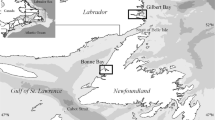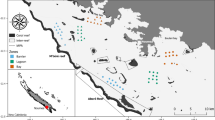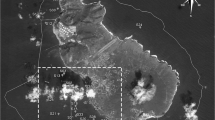Abstract
Increased understanding of latitudinal gradients and patterns of biodiversity at a regional scale is important for many reasons (e.g. biodiversity conservation, species management, climate change). This study assessed rock pool fish assemblages and their relationship to latitude at 39 locations along 860 km of the New South Wales (NSW) coast, eastern Australia, from Sandon to Merimbula (29.67816°S to 36.90046°S). Thirty-minute deployments of miniature baited remote underwater video (mini-BRUV) were used to survey five or more replicates (rock pools) at each location for species richness and maximum number (MaxN) of individual fishes. A total of 371 rock pools were sampled, with 7070 fish recorded from 46 families and 115 species. Fish species richness was greatest in northern NSW, with a significant decline in species richness with increasing latitude, at a rate of 1.7 species per degree of latitude south. Tropical species were dominant in northern NSW (Coffs Harbour ∼30°S), whilst temperate species diversity was greatest towards central NSW (Port Stephens 32.7°S). Differences amongst rock pool assemblages were primarily driven by eight species from eight different families. This study documents latitudinal fish assemblage patterns along the east Australian coast and provides a baseline for elucidating future changes.






Similar content being viewed by others
References
Anderson M, Gorley RN, Clarke RK (2008) PERMANOVA+ for primer: guide to software and statistical methods. PRIMER-E, Plymouth
Arakaki S, Tsuchiya M, Tokeshi M (2014) Testing latitudinal patterns of tidepool fish assemblages: local substrate characteristics affect regional-scale trends. Hydrobiologia 733:45–62
Beger M, Sommer B, Harrison PL, Smith SD, Pandolfi JM (2014) Conserving potential coral reef refuges at high latitudes. Divers Distrib 20:245–257
Boland FM, Church JA (1981) The East Australian Current 1978. Deep Sea Res A Oceanogr Res Pap 28:937–957
Booth D, Figueira W, Gregson M, Brown L, Beretta G (2007) Occurrence of tropical fishes in temperate southeastern Australia: role of the east Australian current. Estuar Coast Shelf Sci 72:102–114
Booth D, Edgar G, Figueira W, Jenkins G, Kingsford M, Lenanton R, Thresher R (2009) Temperate coastal and demersal fish and climate change. In: Poloczanska ES, Hobday AJ, Richardson AJ (eds) A marine climate change impacts and adaptation report card for Australia. National Climate Change Adaptation Research Facility, Publication 05/09, Hobart. Report No. ISBN 978-1-921609-03-9
Bouchon-Navaro Y (1986) Partitioning of food and space resources by chaetodontid fishes on coral reefs. J Exp Mar Biol Ecol 103:21–40. doi:10.1016/0022-0981(86)90130-9
Castellanos-Galindo GA, Giraldo A (2008) Food resource use in a tropical eastern Pacific tidepool fish assemblage. Mar Biol 153:1023–1035
Castro P, Huber ME (2013) Marine biology. McGraw-Hill, New York
Chargulaf C, Townsend K, Tibbetts I (2011) Community structure of soft sediment pool fishes in Moreton Bay, Australia. J Fish Biol 78:479–494
Chen I-C, Hill JK, Ohlemuller R, Roy DB, Thomas CD (2011) Rapid range shifts of species associated with high levels of climate warming. Science 333:1024–1026
Cheung WWL, Meeuwig JJ, Feng M, Harvey E, Lam VWH, Langlois T, Slawinski D, Sun C, Pauly D (2012) Climate-change induced tropicalisation of marine communities in Western Australia. Mar Freshw Res 63:415–427
Colwell RK (2013) EstimateS: Statistical estimation of species richness and shared species from samples. Version 9. User’s Guide and application, http://purl.oclc.org/estimates
Connolly SR, Menge BA, Roughgarden J (2001) A latitudinal gradient in recruitment of intertidal invertebrates in the northeast Pacific Ocean. Ecology 82:1799–1813
Crawley MJ (2012) The R book. John Wiley & Sons, Chichester
Curley BG, Jordan AR, Figueira WF, Valenzuela VC (2013) A review of the biology and ecology of key fishes targeted by coastal fisheries in south-east Australia: identifying critical knowledge gaps required to improve spatial management. Rev Fish Biol Fish 23:435–458
Davis TR, Harasti D, Smith SDA (2015) Developing a habitat classification typology for subtidal habitats in a temperate estuary in New South Wales, Australia. Mar Freshw Res, http://dx.doi.org/10.1071/MF15123
e Costa BH, Assis J, Franco G, Erzini K, Henriques M, Gonçalves EJ, Caselle JE (2014) Tropicalization of fish assemblages at temperate biogeographic transition zones. Mar Ecol Prog Ser 504:241–252
Feary DA, Pratchett MS, J Emslie M, Fowler AM, Figueira WF, Luiz OJ, Nakamura Y, Booth DJ (2013) Latitudinal shifts in coral reef fishes: why some species do and others do not shift. Fish Fish 15:593–615. doi:10.1111/faf.12036
Figueira WF, Booth DJ (2010) Increasing ocean temperatures allow tropical fishes to survive overwinter in temperate waters. Glob Chang Biol 16:506–516
Figueira WF, Biro P, Booth DJ, Valenzuela VC (2009) Performance of tropical fish recruiting to temperate habitats: role of ambient temperature and implications of climate change. Mar Ecol Prog Ser 384:231–239
Floeter SR, Ferreira CEL, Dominici-Arosemena A, Zalmon IR (2004) Latitudinal gradients in Atlantic reef fish communities: trophic structure and spatial use patterns. J Fish Biol 64:1680–1699
Francis MP, Harasti D, Malcolm HA (2015) Surviving under pressure and protection: a review of the biology, ecology and population status of the highly vulnerable grouper, Epinephelus daemelii. Mar Freshw Res. doi:10.1071/MF15099
Godfrey JS, Cresswell GR, Golding TJ, Pearce AF, Boyd R (1980) The separation of the east Australian current. J Phys Oceanogr 10:430–440
Gotelli N, Colwell RK (2001) Quantifying biodiversity: procedures and pitfalls in the measurement and comparison of species richness. Ecol Lett 4:379–391
Griffiths SP (2000) The use of clove oil as an anaesthetic and method for sampling intertidal rockpool fishes. J Fish Biol 57:1453–1464
Griffiths SP (2003a) Rockpool ichthyofaunas of temperate Australia: species composition, residency and biogeographic patterns. Estuar Coast Shelf Sci 58:173–186. doi:10.1016/S0272-7714(03)00073-8
Griffiths SP (2003b) Spatial and temporal dynamics of temperate Australian rockpool ichthyofaunas. Mar Freshw Res 54:163–176
Griffiths SP, West RJ, Davis AR, Russell KG (2004) Fish recolonization in temperate Australian rockpools: a quantitative experimental approach. Fish Bull 102:634–647
Harasti D (2015) Range extension and first occurrence of the thorny seahorse Hippocampus histrix in New South Wales, Australia. Mar Biodivers Rec 8:1–3. doi:10.1017/S1755267215000263
Harasti D, Malcolm H (2013) Distribution, relative abundance and size composition of the threatened serranid Epinephelus daemelii in New South Wales, Australia. J Fish Biol 83:378–395
Harasti D, Gallen C, Malcolm H, Tegart P, Hughes B (2014a) Where are the little ones: distribution and abundance of the threatened serranid Epinephelus daemelii (Gunther, 1876) in intertidal habitats in New South Wales, Australia. J Appl Ichthyol 30:1007–1015
Harasti D, Martin‐Smith K, Gladstone W (2014b) Ontogenetic and sex based differences in habitat preferences and site fidelity of White’s seahorse Hippocampus whitei. J Fish Biol 85:1413–1428
Harasti D, Malcolm H, Gallen C, Coleman MA, Jordan A, Knott NA (2015) Appropriate set times to represent patterns of rocky reef fishes using baited video. J Exp Mar Biol Ecol 463:173–180
Hawkins BA, Porter EE, Felizola Diniz-Filho JA (2003) Productivity and history as predictors of the latitudinal diversity gradient of terrestrial birds. Ecology 84:1608–1623
Hobday AJ, Lough JM (2011) Projected climate change in Australian marine and freshwater environments. Mar Freshw Res 62:1000–1014
Hobday AJ, Pecl GT (2014) Identification of global marine hotspots: sentinels for change and vanguards for adaptation action. Rev Fish Biol Fish 24:415–425
Horn MH, Martin KL, Chotkowski MA (1998) Intertidal fishes: life in two worlds. Academic Press, San Diego
Hunter PR, Gaston MA (1988) Numerical index of the discriminatory ability of typing systems: an application of Simpson’s index of diversity. J Clin Microbiol 26:2465–2466
Krück NC, Chargulaf CA, Saint-Paul U, Tibbetts IR (2009) Early post-settlement habitat and diet shifts and the nursery function of tidepools during Sillago spp. recruitment in Moreton Bay, Australia. Mar Ecol Prog Ser 384:207–219
Kuiter RH (1993) Coastal fishes of South-Eastern Australia. Crawford House Press Pty Ltd, Bathurst
Kumar CS, Mishra JK, Kumar NP (2016) Diversity and distribution of tide pool ornamental fishes along the Andaman coast (Andaman Sea), India. Mar Biodivers 46:433–441. doi:10.1007/s12526-015-0385-x
Langlois TJ, Radford BT, Van Niel KP, Meeuwig JJ, Pearce AF, Rousseaux CSG, Kendrick GA, Harvey ES (2012) Consistent abundance distributions of marine fishes in an old, climatically buffered, infertile seascape. Glob Ecol Biogeogr 21:886–897
Lasram FBR, Mouillot D (2009) Increasing southern invasion enhances congruence between endemic and exotic Mediterranean fish fauna. Biol Invasions 11:697–711
Lloyd P, Plagányi EE, Weeks SJ, Magno-Canto M, Plagányi G (2012) Ocean warming alters species abundance patterns and increases species diversity in an African sub-tropical reef-fish community. Fish Oceanogr 21:78–94
Malcolm H, Lindfield S, Wraith J, Lynch T, Gladstone W (2007) Spatial and temporal variation in reef fish assemblages of marine parks in New South Wales, Australia—baited video observations. Mar Ecol Prog Ser 350:277–290
Malcolm HA, Jordan A, Smith SDA (2010) Biogeographical and cross-shelf patterns of reef fish assemblages in a transition zone. Mar Biodivers 40:181–193
Marliave JB (1986) Lack of planktonic dispersal of rocky intertidal fish larvae. Trans Am Fish Soc 115:149–154
Matear R, Chamberlain M, Sun C, Feng M (2013) Climate change projection of the Tasman Sea from an Eddy-resolving Ocean Model. J Geophys Res : Oceans 118:2961–2976
Meekan MG, Choat JH (1997) Latitudinal variation in abundance of herbivorous fishes: a comparison of temperate and tropical reefs. Mar Biol 128:373–383
Nakamura Y, Feary DA, Kanda M, Yamaoka K (2013) Tropical fishes dominate temperate reef fish communities within western Japan. PLoS One 8:e81107. doi:10.1371/journal.pone.0081107
Nimbs MJ, Willan RC, Smith SD (2015) Range extensions for heterobranch sea slugs (formerly opisthobranch) belonging to the families Diaphanidae, Plakobranchidae and Facelinidae on the eastern coast of Australia. Mar Biodivers Rec 8:e76
Nimbs MJ, Larkin M, Davis T, Harasti D, Willan RC, Smith SDA (2016) Southern range extensions for twelve heterobranch sea slugs (Gastropoda: Heterobranchia) on the eastern coast of Australia. Mar Biodivers Rec. doi:10.1186/s41200-016-0027-4
Oke PR, Middleton JH (2001) Nutrient enrichment off Port Stephens: the role of the East Australian Current. Cont Shelf Res 21:587–606
Parmesan C, Yohe G (2003) A globally coherent fingerprint of climate change impacts across natural systems. Nature 421:37–42
Poloczanska ES, Babcock RC, Butler A, Hobday AJ, Hoegh-Guldberg O, Kunz TJ, Matear R, Milton DA, Okey TA, Richardson AJ (2007) Climate change and Australian marine life. Oceanogr Mar Biol 45:407–478
Poulos D, Gallen C, Davis T, Booth D, Harasti D (2015) Distribution and spatial modelling of a soft coral habitat in the Port Stephens-Great Lakes Marine Park: implications for management. Mar Freshw Res 67:256–265. doi:10.1071/MF14059
Roughan M, Middleton JH (2004) On the East Australian Current: variability, encroachment, and upwelling. J Geophys Res Oceans 109:1–16. doi:10.1029/2003JC001833
Ruzicka R, Gleason DF (2008) Latitudinal variation in spongivorous fishes and the effectiveness of sponge chemical defenses. Oecologia 154:785–794
Scott A, Malcolm HA, Damiano C, Richardson DL (2011) Long-term increases in abundance of anemonefish and their host sea anemones in an Australian marine protected area. Mar Freshw Res 62:187–196
Scott A, Harasti D, Davis T, Smith SD (2014) Southernmost records of the host sea anemone, Stichodactyla haddoni, and associated commensal shrimps in a climate change hotspot. Mar Biodivers 1–2. DOI 10.1007/s12526-014-0237-0
Silberschneider V, Booth DJ (2001) Resource use by Enneapterygius rufopileus and other rockpool fishes. Environ Biol Fish 61:195–204
Sindorf V, Cowburn B, Sluka RD (2015) Rocky intertidal fish assemblage of the Watamu Marine National Park, Kenya (Western Indian Ocean). Environ Biol Fish 98:1777–1785
Smith KF, Gaines SD (2003) Rapoport’s bathymetric rule and the latitudinal species diversity gradient for Northeast Pacific fishes and Northwest Atlantic gastropods: Evidence against a causal link. J Biogeogr 30:1153–1159
Somero GN (2009) The physiology of climate change: how potentials for acclimatization and genetic adaptation will determine ‘winners’ and ‘losers’. J Exp Biol 213:912–920
Stevens GC (1989) The latitudinal gradient in geographical range: how so many species coexist in the tropics. Am Nat 240-256
Sun C, Feng M, Matear RJ, Chamberlain MA, Craig P, Ridgway KR, Schiller A (2012) Marine downscaling of a future climate scenario for Australian boundary currents. J Clim 25:2947–2962
Sunday JM, Bates AE, Dulvy NK (2011) Global analysis of thernal tolerance and latitude in ectotherms. Proc Roy Soc Biol Sci 278:1823–1830
Suthers IM, Young JW, Baird ME, Roughan M, Everett JD, Brassington GB, Byrne M, Condie SA, Hartog JR, Hassler CS (2010) The strengthening east Australian current, its eddies and biological effects—an introduction and overview. Deep Sea Res II: The East Aust Curr – Eddies Impacts 58:538–546
Thomas CD, Cameron A, Green RE, Bakkenes M, Beaumont LJ, Collingham YC, Erasmus BF, De Siqueira MF, Grainger A, Hannah L (2004) Extinction risk from climate change. Nature 427:145–148
Travers MJ, Newman SJ, Potter IC (2006) Influence of latitude, water depth, day v. night and wet v. dry periods on the species composition of reef fish communities in tropical Western Australia. J Fish Biol 69:987–1017
White GE, Brown C (2013) Site fidelity and homing behaviour in intertidal fishes. Mar Biol 160:1365–1372
White GE, Hose GC, Brown C (2014) Influence of rock‐pool characteristics on the distribution and abundance of inter tidal fishes. Mar Ecol 36:1332–1344. doi:10.1111/maec.12232
Whitfield PE, Gardner T, Vives SP, Gilligan MR, Courtenay WR Jr, Ray GC, Hare JA (2002) Biological invasion of the Indo-Pacific lionfish Pterois volitans along the Atlantic coast of North America. Mar Ecol Prog Ser 235:289–297
Acknowledgments
This project was made possible with funding assistance from the Hunter-Central Rivers Local Land Services. Assistance with data collection was provided by Patrick Tegart, Ellie Marks, Jack McNamara and Brian Hughes. Thanks to Dr Kate Lee and Dr Ashley Fowler from NSW DPI, and to two anonymous reviewers for comments that helped improve the manuscript.
Author information
Authors and Affiliations
Corresponding author
Additional information
Communicated by R. Serrao Santos
Electronic supplementary material
Below is the link to the electronic supplementary material.
ESM 1
(DOCX 103 kb)
Rights and permissions
About this article
Cite this article
Harasti, D., McLuckie, C., Gallen, C. et al. Assessment of rock pool fish assemblages along a latitudinal gradient. Mar Biodiv 48, 1147–1158 (2018). https://doi.org/10.1007/s12526-016-0560-8
Received:
Accepted:
Published:
Issue Date:
DOI: https://doi.org/10.1007/s12526-016-0560-8




